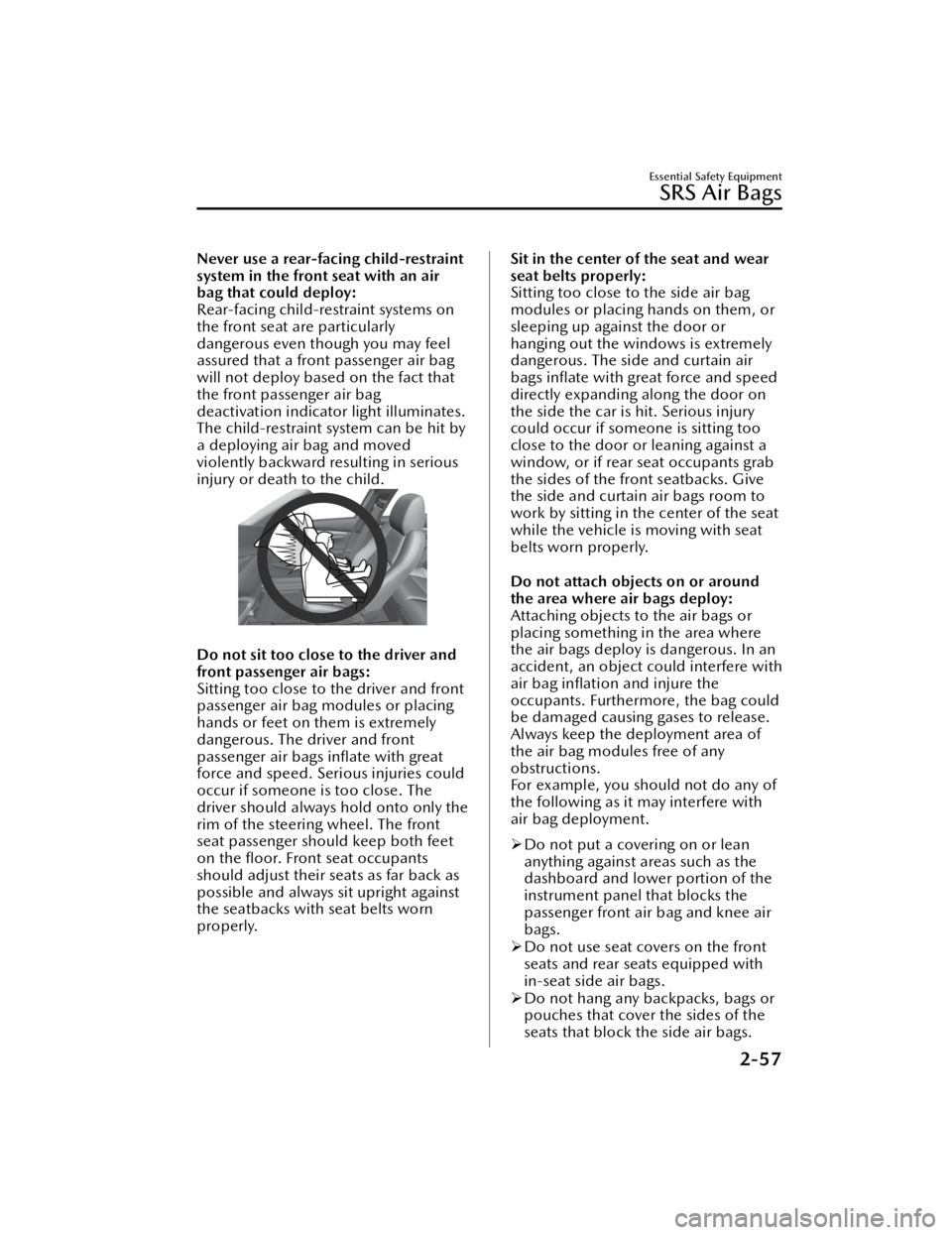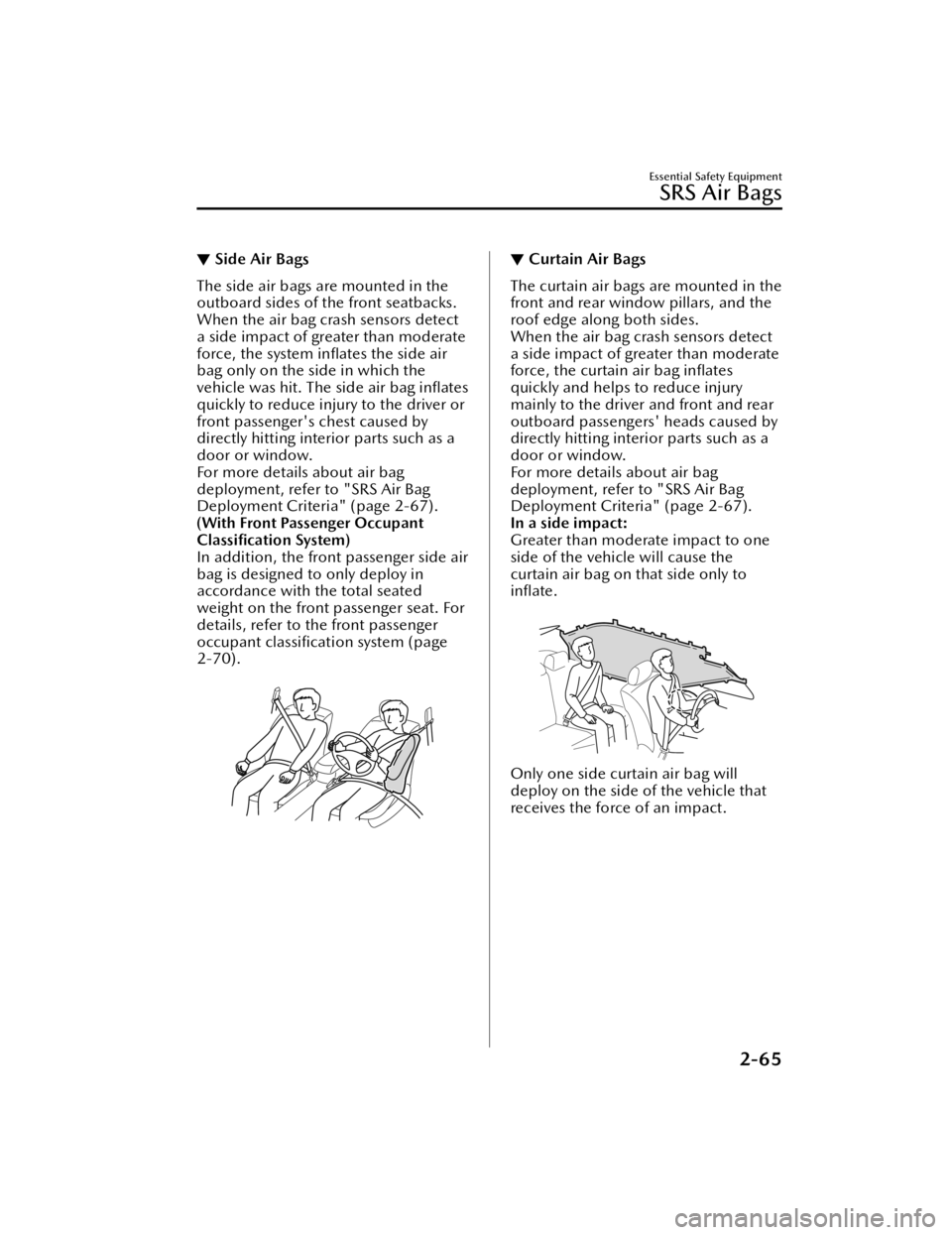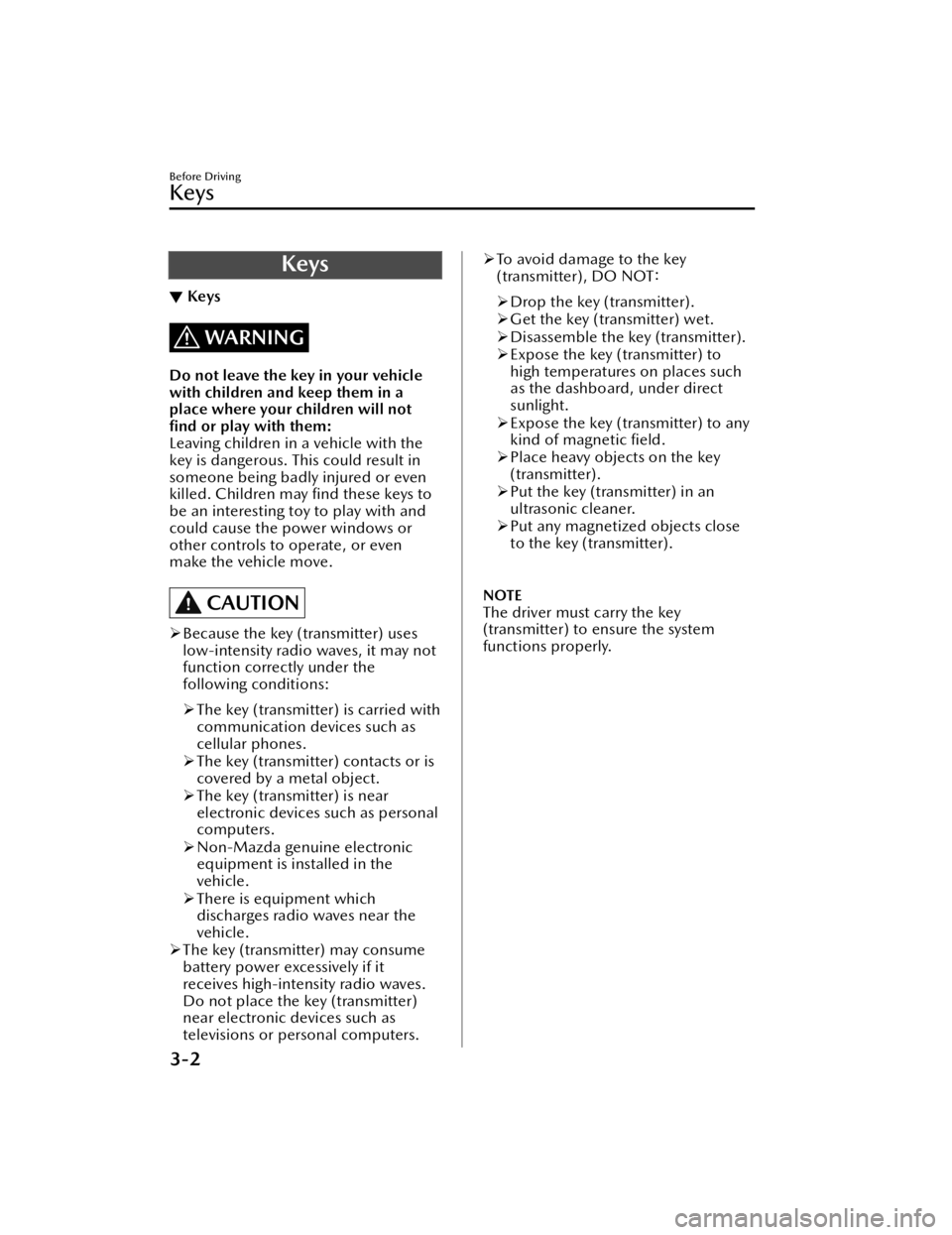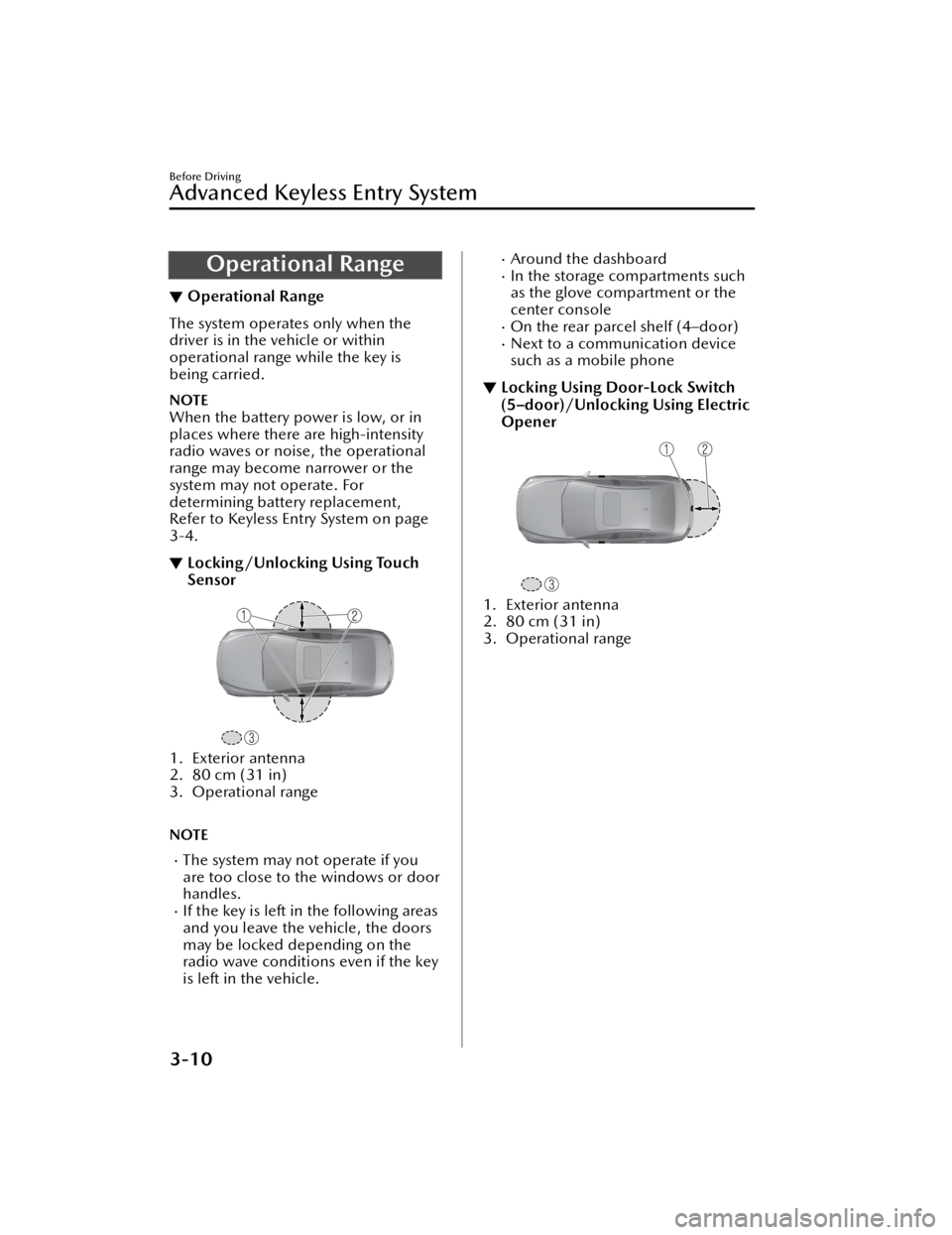window MAZDA MODEL 3 HATCHBACK 2021 User Guide
[x] Cancel search | Manufacturer: MAZDA, Model Year: 2021, Model line: MODEL 3 HATCHBACK, Model: MAZDA MODEL 3 HATCHBACK 2021Pages: 612, PDF Size: 89.06 MB
Page 71 of 612

Never use a rear-facing child-restraint
system in the front seat with an air
bag that could deploy:
Rear-facing child-restraint systems on
the front seat are particularly
dangerous even though you may feel
assured that a front passenger air bag
will not deploy based on the fact that
the front passenger air bag
deactivation indicator light illuminates.
The child-restraint system can be hit by
a deploying air bag and moved
violently backward resulting in serious
injury or death to the child.
Do not sit too close to the driver and
front passenger air bags:
Sitting too close to the driver and front
passenger air bag modules or placing
hands or feet on them is extremely
dangerous. The driver and front
passenger air bags inflate with great
force and speed. Serious injuries could
occur if someone is too close. The
driver should always hold onto only the
rim of the steering wheel. The front
seat passenger should keep both feet
on the floor. Front seat occupants
should adjust their seats as far back as
possible and always sit upright against
the seatbacks with seat belts worn
properly.
Sit in the center of the seat and wear
seat belts properly:
Sitting too close to the side air bag
modules or placing hands on them, or
sleeping up against the door or
hanging out the windows is extremely
dangerous. The side and curtain air
bags in flate with great force and speed
directly expanding along the door on
the side the car is hit. Serious injury
could occur if someone is sitting too
close to the door or leaning against a
window, or if rear seat occupants grab
the sides of the front seatbacks. Give
the side and curtain air bags room to
work by sitting in the center of the seat
while the vehicle is moving with seat
belts worn properly.
Do not attach objects on or around
the area where air bags deploy:
Attaching objects to the air bags or
placing something in the area where
the air bags deploy is dangerous. In an
accident, an object could interfere with
air bag in flation and injure the
occupants. Furthermore, the bag could
be damaged causing gases to release.
Always keep the deployment area of
the air bag modules free of any
obstructions.
For example, you should not do any of
the following as it may interfere with
air bag deployment.
Do not put a covering on or lean
anything against areas such as the
dashboard and lower portion of the
instrument panel that blocks the
passenger front air bag and knee air
bags.
Do not use seat covers on the front
seats and rear seats equipped with
in-seat side air bags.
Do not hang any backpacks, bags or
pouches that cover the sides of the
seats that block the side air bags.
Essential Safety Equipment
SRS Air Bags
2-57
Mazda3_8JM2-EA -20H_Edition1_new 2020-7-10 17:21:34
Page 73 of 612

Do not modify a front door or leave
any damage unrepaired. Always have
an Authorized Mazda Dealer inspect a
damaged front door:
Modifying a front door or leaving any
damage unrepaired is dangerous. Each
front door has a side crash sensor as a
component of the supplemental
restraint system. If holes are drilled in a
front door, a door speaker is left
removed, or a damaged door is left
unrepaired, the sensor could be
adversely affected causing it to not
detect the pressure of an impact
correctly during a si de collision. If a
sensor does not detect a side impact
correctly, the side and curtain air bags
and the front seat belt pretensioner
may not operate norm ally which could
result in serious injury to occupants.
Do not modify the supplemental
restraint system:
Modifying the components or wiring of
the supplemental restraint system is
dangerous. You could accidentally
activate it or make it inoperable. Do
not make any modi fications to the
supplemental restraint system. This
includes installing trim, badges, or
anything else over the air bag modules.
It also includes installing extra
electrical equipment on or near system
components or wiring. An Authorized
Mazda Dealer can provide the special
care needed in the removal and
installation of front seats. It is
important to protect the air bag wiring
and connections to assure that the
bags do not accidentally deploy, and
that the front passenger occupant
classi fication system and the seats
retain an undamaged air bag
connection.Do not place luggage or other objects
under the front seats:
Placing luggage or other objects under
the front seats is dangerous. The
components essential to the
supplemental restraint system could be
damaged, and in the event of a side
collision, the appropriate air bags may
not deploy, which could result in death
or serious injury. To prevent damage to
the components essential to the
supplemental restraint system, do not
place luggage or other objects under
the front seats.
Do not operate a vehicle with
damaged air bag/seat belt
pretensioner system components:
Expended or damaged air bag/seat
belt pretensioner system components
must be replaced after any collision
which caused them to deploy or
damage them. Only a trained
Authorized Mazda Dealer can fully
evaluate these systems to see that they
will work in any subsequent accident.
Driving with an expended or damaged
air bag or pretensioner unit will not
a ff ord you the necessary protection in
the event of any subsequent accident
which could result in serious injury or
death.
Do not remove interior air bag parts:
Removing any components such as the
front seats, front dashboard, the
steering wheel or pa rts on the front
and rear window pillars and along the
roof edge, containing air bag parts or
sensors is dangerous. These parts
contain essential air bag components.
The air bag could accidentally activate
and cause serious injuries. Always have
an Authorized Mazda Dealer remove
these parts.
Essential Safety Equipment
SRS Air Bags
2-59
Mazda3_8JM2-EA -20H_Edition1_new 2020-7-10 17:21:34
Page 79 of 612

▼Side Air Bags
The side air bags are mounted in the
outboard sides of the front seatbacks.
When the air bag crash sensors detect
a side impact of greater than moderate
force, the system in
flates the side air
bag only on the side in which the
vehicle was hit. The side air bag in flates
quickly to reduce injury to the driver or
front passenger's chest caused by
directly hitting interior parts such as a
door or window.
For more details about air bag
deployment, refer to "SRS Air Bag
Deployment Criteria" (page 2-67).
(With Front Passenger Occupant
Classi fication System)
In addition, the front passenger side air
bag is designed to only deploy in
accordance with the total seated
weight on the front passenger seat. For
details, refer to the front passenger
occupant classi fication system (page
2-70).
▼ Curtain Air Bags
The curtain air bags are mounted in the
front and rear window pillars, and the
roof edge along both sides.
When the air bag crash sensors detect
a side impact of greater than moderate
force, the curtain air bag in
flates
quickly and helps to reduce injury
mainly to the driver and front and rear
outboard passengers' heads caused by
directly hitting interior parts such as a
door or window.
For more details about air bag
deployment, refer to "SRS Air Bag
Deployment Criteria" (page 2-67).
In a side impact:
Greater than moderate impact to one
side of the vehicle will cause the
curtain air bag on that side only to
in flate.
Only one side curtain air bag will
deploy on the side of the vehicle that
receives the force of an impact.
Essential Safety Equipment
SRS Air Bags
2-65
Mazda3_8JM2-EA -20H_Edition1_new 2020-7-10 17:21:34
Page 91 of 612

3Before Driving
Use of various features, including keys, doors, mirrors and
windows.
Keys........................................ 3-2 Keys...................................... 3-2
Keyless Entry System...............3-4
Advanced Keyless Entry
System.....................................3-9 Advanced Keyless Entry
System
*................................. 3-9
Operational Range...............3-10
Doors and Locks..................... 3-11 Door Locks.......................... 3-11
Liftgate/Trunk Lid.................3-19
Inside Trunk Release Lever (4-
door)
*................................. 3-24
Fuel and Emission................... 3-25 Fuel and Engine Exhaust
Precautions......................... 3-25
Fuel-Filler Lid and Cap..........3-27
Mirrors.................................. 3-30 Mirrors................................3-30
Windows............................... 3-34 Power Windows...................3-34
Moonroof*.......................... 3-37
Security System.......................3-40 Modi fication and Add-
On Equipment..................... 3-40
Immobilizer System..............3-40
Theft-Deterrent System
*........3-42
Driving Tips............................ 3-44 Break-In Period.................... 3-44
Saving Fuel and Protection of the
Environment........................ 3-44
Hazardous Driving............... 3-45
Floor Mat............................ 3-46
Rocking the Vehicle..............3-46
Winter Driving..................... 3-47
Driving In Flooded Area........3-49
Overloading........................ 3-49
Driving on Uneven Road.......3-50
Turbocharger Information
(SKYACTIV -G 2.5T).............. 3-50
Towing.................................. 3-51 Trailer Towing...................... 3-51
Recreational Towing............. 3-51
*Some models.3-1
Mazda3_8JM2-EA -20H_Edition1_new 2020-7-10 17:21:34
Page 92 of 612

Keys
▼Keys
WARNING
Do not leave the key in your vehicle
with children and keep them in a
place where your children will not
fi
nd or play with them:
Leaving children in a vehicle with the
key is dangerous. This could result in
someone being badly injured or even
killed. Children may find these keys to
be an interesting toy to play with and
could cause the power windows or
other controls to operate, or even
make the vehicle move.
CAUTION
Because the key (transmitter) uses
low-intensity radio waves, it may not
function correctly under the
following conditions:
The key (transmitter) is carried with
communication devices such as
cellular phones.
The key (transmitter) contacts or is
covered by a metal object.
The key (transmitter) is near
electronic devices such as personal
computers.
Non-Mazda genuine electronic
equipment is installed in the
vehicle.
There is equipment which
discharges radio waves near the
vehicle.
The key (transmitter) may consume
battery power excessively if it
receives high-intensity radio waves.
Do not place the key (transmitter)
near electronic devices such as
televisions or personal computers.
To avoid damage to the key
(transmitter), DO NOT :
Drop the key (transmitter).
Get the key (transmitter) wet.
Disassemble the key (transmitter).
Expose the key (transmitter) to
high temperatures on places such
as the dashboard, under direct
sunlight.
Expose the key (transmitter) to any
kind of magnetic field.
Place heavy objects on the key
(transmitter).
Put the key (transmitter) in an
ultrasonic cleaner.
Put any magnetized objects close
to the key (transmitter).
NOTE
The driver must carry the key
(transmitter) to ensure the system
functions properly.
Before Driving
Keys
3-2
Mazda3_8JM2-EA -20H_Edition1_new 2020-7-10 17:21:34
Page 97 of 612

(Turning on the alarm)
Pressing the panic button for 1 second
or more will trigger the alarm for about
2 minutes and 30 seconds, and the
following will occur:
The horn sounds intermittently.The hazard warning lights flash.
(Turning off the alarm)
The alarm stops by pressing any button
on the key.
Power saving function
By turning on the transmitter power
saving function, the advanced keyless
entry
*1 and push button start system
functions turn o ff and the battery
power consumption of the transmitter
is restricted.
The remote control function is
operational by operating the
transmitter switch even while the
power saving function is turned on.
However, the operation indicator light
of the transmitter does not turn on/
fl ash.
Turning on the power saving function
After you have turned on the power
saving function according to the
following procedure, the hazard
warning lights and sound operate
*1
one time.
1. Press the lock button on the transmitter 4 times within 3
seconds to turn on the operation
indicator light.
2. Press the lock button continuously for 1.5 seconds or longer while the
operation indicator light turns on
(for 5 seconds).
3. Press any of the buttons on the transmitter to make sure that the
operation indicator light does not
turn on/ flash.
Tu r n i n g o ff the power saving function
After you have turned off the power
saving function according to the
following procedure, the hazard
warning lights and sound operate
*1
one time.
1. Press any of the buttons on the transmitter to make sure that the
operation indicator light does not
turn on/fl ash.
2. Press the lock button on the transmitter 4 times within 3
seconds to turn on the operation
indicator light.
3. Press the lock button continuously for 1.5 seconds or longer while the
operation indicator light turns on
(for 5 seconds).
*1 With the advanced keyless function
▼Operational Range
The system operates only when the
driver is in the vehicle or within
operational range while the key is
being carried.
Starting the engine
NOTE
Starting the engine may be possible
even if the key is outside of the
vehicle and extremely close to a door
and window, however, always start
the engine from the driver's seat.
If the vehicle is started and the key is
not in the vehicle, the vehicle will not
restart after it is shut o
ff and the
ignition is switched o ff.
The luggage compartment/trunk is
out of the assured operational range,
however, if the key (transmitter) is
operable the engine will start.
Before Driving
Keys
3-7
Mazda3_8JM2-EA -20H_Edition1_new 2020-7-10 17:21:34
Page 100 of 612

Operational Range
▼Operational Range
The system operates only when the
driver is in the vehicle or within
operational range while the key is
being carried.
NOTE
When the battery power is low, or in
places where there are high-intensity
radio waves or noise, the operational
range may become narrower or the
system may not operate. For
determining battery replacement,
Refer to Keyless Entry System on page
3-4.
▼Locking/Unlocking Using Touch
Sensor
1. Exterior antenna
2. 80 cm (31 in)
3. Operational range
NOTE
The system may not operate if you
are too close to the windows or door
handles.
If the key is left in the following areas
and you leave the vehicle, the doors
may be locked depending on the
radio wave conditions even if the key
is left in the vehicle.
Around the dashboardIn the storage compartments such
as the glove compartment or the
center console
On the rear parcel shelf (4–door)Next to a communication device
such as a mobile phone
▼
Locking Using Door-Lock Switch
(5–door)/Unlocking Using Electric
Opener
1. Exterior antenna
2. 80 cm (31 in)
3. Operational range
Before Driving
Advanced Keyless Entry System
3-10
Mazda3_8JM2-EA
-20H_Edition1_new 2020-7-10 17:21:34
Page 101 of 612

Door Locks
▼Door Locks
WARNING
Always take all children and pets with
you or leave a responsible person
with them:
Leaving a child or a pet unattended in
a parked vehicle is dangerous. In hot
weather, temperatures inside a vehicle
can become high enough to cause
brain damage or even death.
Do not leave the key in your vehicle
with children and keep them in a
place where your children will not
fi
nd or play with them:
Leaving children in a vehicle with the
key is dangerous. This could result in
someone being badly injured or even
killed.
Keep all doors locked when driving:
Unlocked doors in a moving vehicle
are dangerous. Passengers can fall out
if a door is accidentally opened and
can more easily be thrown out in an
accident.
Always close all the windows and
moonroof, lock the doors, fuel-filler
lid, and liftgate and take the key with
you when leaving your vehicle
unattended:
Leaving your vehicle unlocked is
dangerous as children could lock
themselves in a hot vehicle, which
could result in death. Also, a vehicle
left unlocked becomes an easy target
for thieves and intruders.
After closing the doors and the
liftgate/trunk lid, always verify that
they are securely closed:
Doors and the liftgate/trunk lid not
securely closed are dangerous, if the
vehicle is driven with a door and the
liftgate/trunk lid not securely closed,
the door and the liftgate/trunk lid
could open unexpectedly resulting in
an accident.
Always con firm the safety around the
vehicle before opening a door and the
liftgate/trunk lid:
Suddenly opening a door and the
liftgate/trunk lid is dangerous. A
passing vehicle or a pedestrian could
be hit and cause an accident.
CAUTION
Always
confirm the conditions
around the vehicle before opening/
closing the doors and the liftgate/
trunk lid and use caution during
strong winds or when parked on an
incline. Not being aware of the
conditions around the vehicle is
dangerous because fingers could get
caught in the door and the liftgate/
trunk lid or a passing pedestrian
could be hit, resulting in an
unexpected accident or injury.
Before Driving
Doors and Locks
3-11
Mazda3_8JM2-EA -20H_Edition1_new 2020-7-10 17:21:34
Page 105 of 612

A beep sound is heard for
confirmation when the doors,
fuel- filler lid, and liftgate are locked/
unlocked using the touch sensor. If
you prefer, the beep sound can be
turned o ff.
The volume of the beep sound can
also be changed. Refer to the
Settings section in the Mazda
Connect Owner's Manual.
(With theft-deterrent system)
The hazard warning lights flash when
the theft-deterrent system is armed
or turned o ff.
Refer to Theft-Deterrent System on
page 3-42.
The setting can be changed so that
the doors, fuel- filler lid, and liftgate
are locked automatically without
touching the sensing area of the
touch sensor.
Refer to the Settings section in the
Mazda Connect Owner's Manual.
(Walk-away auto lock function)
A beep sound is heard when all
doors and the liftgate/trunk lid are
closed while the transmitter is being
carried. All the doors, fuel- filler lid,
and liftgate are locked automatically
when the transmitter is out of the
operational range. Also, the hazard
warning lights flash once. (Even if the
driver is in the operational range, all
the doors, fuel- filler lid, and liftgate
are locked automatically after about
30 seconds.) If you are out of the
operational range before the doors
and the liftgate/trunk lid are
completely closed or another
transmitter is left in the vehicle, the
walk-away auto lock function will
not work. Always make sure that all
doors and the liftgate/trunk lid are
closed and locked before leaving the
vehicle. The walk-away auto lock
function does not close the power
windows.
Before Driving
Doors and Locks
3-15
Mazda3_8JM2-EA -20H_Edition1_new 2020-7-10 17:21:34
Page 116 of 612

▼Emission Control System
This vehicle is equipped with an
emission control system (the catalytic
converter is part of this system) that
enables the vehicle to comply with
existing exhaust emissions
requirements.
WARNING
Never park over or near anything
fl
ammable:
Parking over or near anything
fl ammable, such as dry grass, is
dangerous. Even with the engine
turned o ff, the exhaust system remains
very hot after normal use and could
ignite anything flammable. A resulting
fire could cause serious injury or death.
CAUTION
Ignoring the following precautions
could cause lead to accumulate on the
catalyst inside the converter or cause
the converter to get very hot. Either
condition will damage the converter
and cause poor performance.
USE ONLY UNLEADED FUEL.
Do not drive your Mazda with any
sign of engine malfunction.
Do not coast with the ignition
switched o ff.
Do not descend steep grades in gear
with the ignition switched o ff.
Do not operate the engine at high
idle for more than 2 minutes.
Do not tamper with the emission
control system. All inspections and
adjustments must be made by a
quali fied technician.
Do not push-start or pull-start this
vehicle.
NOTE
Under U.S. federal law, any
modi fication to the
original-equipment emission control
system before the first sale and
registration of a vehicle is subject to
penalties. In some states, such modi fication made on a used vehicle
is also subject to penalties.
While the engine is o ff, the sound of
a valve opening and closing can be
heard at the rear of the vehicle,
however this does not indicate an
abnormality. The vehicle has a
self-checking device and it operates
while the engine is o ff.
▼ Engine Exhaust (Carbon
monoxide)
WARNING
Do not drive your vehicle if you smell
exhaust gas inside the vehicle:
Engine exhaust gas is dangerous. This
gas contains carbon monoxide (CO),
which is colorless, odorless, and
poisonous. When inhaled, it can cause
loss of consciousness and death. If you
smell exhaust gas inside the vehicle,
keep all windows fully open and
contact an Authorized Mazda Dealer
immediately.
Before Driving
Fuel and Emission
3-26
Mazda3_8JM2-EA
-20H_Edition1_new 2020-7-10 17:21:34